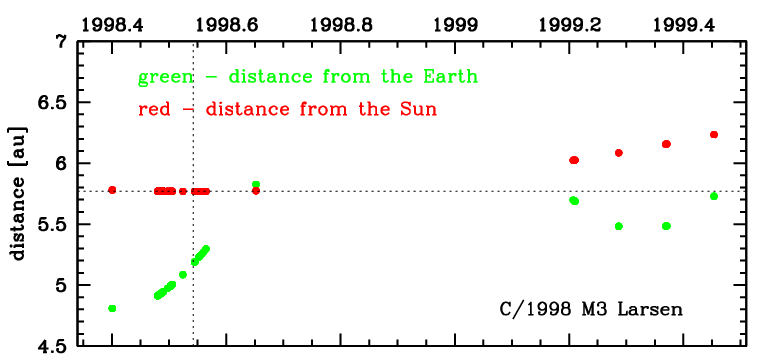C/1998 M3 Larsen
more info
Comet C/1998 M3 was discovered by J. Larsen on 24 June 1998 (less than a month before perihelion passage) but prediscovery observations made by LINEAR were found in images taken on 26 May.
Comet had its closest approach to the Earth on 31 May 1998 (4.805 au, almost a month before its discovery), and was observed 1.1 yr in a range of heliocentric distances: 5.78 au – 5.77 au (perihelion) – 6.24 au.
This comet suffers slight planetary perturbations during its passage through the planetary system that lead to a more tight future orbit (see future barycentric orbit).
See also Królikowska and Dybczyński 2017.
Comet had its closest approach to the Earth on 31 May 1998 (4.805 au, almost a month before its discovery), and was observed 1.1 yr in a range of heliocentric distances: 5.78 au – 5.77 au (perihelion) – 6.24 au.
This comet suffers slight planetary perturbations during its passage through the planetary system that lead to a more tight future orbit (see future barycentric orbit).
See also Królikowska and Dybczyński 2017.
| solution description | ||
|---|---|---|
| number of observations | 110 | |
| data interval | 1998 05 26 – 1999 06 14 | |
| data type | perihelion within the observation arc (FULL) | |
| data arc selection | entire data set (STD) | |
| range of heliocentric distances | 5.78 au – 5.77 au (perihelion) – 6.24 au | |
| detectability of NG effects in the comet's motion | NG effects not determinable | |
| type of model of motion | GR - gravitational orbit | |
| data weighting | YES | |
| number of residuals | 219 | |
| RMS [arcseconds] | 0.66 | |
| orbit quality class | 1b | |
| orbital elements (heliocentric ecliptic J2000) | ||
|---|---|---|
| Epoch | 1998 07 06 | |
| perihelion date | 1998 07 17.14159245 | ± 0.01472911 |
| perihelion distance [au] | 5.76830630 | ± 0.00004016 |
| eccentricity | 1.00222152 | ± 0.00003287 |
| argument of perihelion [°] | 20.840919 | ± 0.001485 |
| ascending node [°] | 255.525387 | ± 0.000071 |
| inclination [°] | 113.420178 | ± 0.000108 |
| reciprocal semi-major axis [10-6 au-1] | -385.12 | ± 5.69 |
